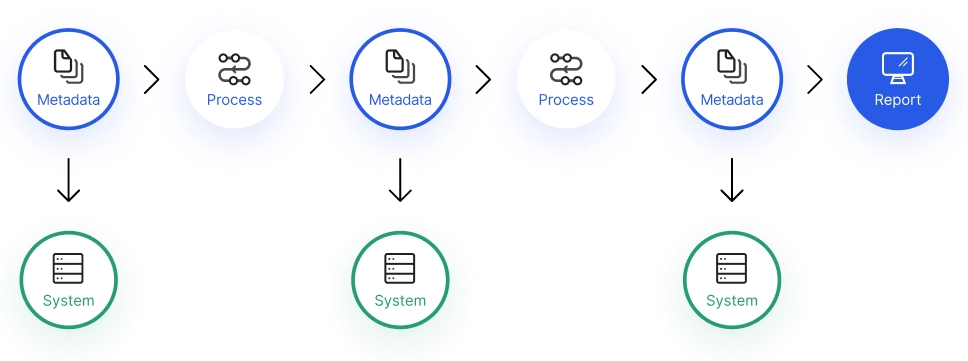Understanding Data Lineage
Definition of Data Lineage
Techniques for Data Lineage
Data lineage involves various techniques that help organizations track the flow and transformations of strategic datasets. Below are some common methods employed to perform data lineage effectively.
Pattern-Based Lineage
Pattern-based lineage evaluates metadata associated with tables, columns, and business reports to determine lineage without requiring access to the underlying code. By analyzing this metadata for recognizable patterns, it links similar datasets together. For example, if two datasets have a column with the same name and similar data values, they are likely related stages in the data lifecycle.
The primary advantage of this approach is its technology-agnostic nature, enabling use across different database technologies, including Oracle, MySQL, and Spark. However, its accuracy can be limited, as it may overlook connections between datasets when data processing logic is embedded in the code and not reflected in the metadata.
Lineage by Data Tagging
This technique relies on a transformation engine that marks or tags data throughout its lifecycle. It tracks these tags from origin to destination to discover lineage. The effectiveness of this method depends on having a consistent transformation tool that governs all data movement and a clear understanding of the tagging structure it uses.
However, lineage by data tagging is only applicable within closed data systems. It cannot be used for data generated or transformed outside the designated tool.
Self-Contained Lineage
Organizations with a controlled data environment often utilize self-contained lineage techniques. These environments typically integrate storage, processing logic, and master data management (MDM), such as data lakes that retain data in all stages of its lifecycle.
Self-contained systems can inherently provide lineage without external tools. However, like the data tagging approach, this method may not account for any data activities that occur outside this controlled environment.
Also Read: Understanding Data Fabrics in Modern Data Management System
Lineage by Parsing
Parsing represents the most advanced lineage technique, as it automatically reads the logic used in data processing. This method reverse engineers data transformation logic, enabling comprehensive end-to-end tracing.
Key Components of Data Lineage Tools
Data lineage consists of several interlinked components that collectively enable effective tracking and management of data throughout its lifecycle. These components include:
1. IT Systems
Data flows through various IT systems, including applications, databases, and network segments. This flow represents the transformation and integration of data. The ‘golden sources’ and final reports or dashboards serve as critical boundaries, marking the point of data creation and its ultimate destination.
2. Business Processes
Business processes encompass a set of activities related to data processing. These processes typically reference associated applications, ensuring a structured approach to managing data within the organization.
3. Data Elements
Data elements are essential components of data lineage, defined across various levels of abstraction. They can be categorized into the following data model levels:
- Conceptual Level: Data elements are represented as terms and associated constraints.
- Logical, Application Related: Data entities and attributes specific to a database, along with related transformation rules.
- Logical, Non-Application Related: Data entities and attributes independent of any application, along with their transformation rules.
- Physical Level: Tables and columns, including related ETL (Extract, Transform, Load) processes.
It is beneficial to link data elements across different data model levels, often referred to as ‘vertical data lineage,’ in contrast to ‘horizontal data lineage,’ which depicts the journey from data origination to usage.
4. Data Checks and Controls
According to the Enterprise Data Management Council, data lineage may include mapping data controls. Legislative requirements often interpret specific components of data lineage, ensuring compliance with regulations.
5. Information and Reports
Regulatory frameworks emphasize the importance of providing the right information to relevant parties at the right time. This includes distributing risk reports and dashboards that align with organizational needs.
6. Business Dictionary
BCBS239 highlights the necessity of a business dictionary to ensure consistent definitions of concepts used in reports across the organization. This dictionary aligns with the conceptual level of data models.
7. Data Elements and Business Rules at Logical Level
Regulatory guidelines require organizations to maintain an inventory and classification of risk data items. This includes automated and manual checks, as well as a repository of business rules that govern data validation and relationships.
8. Application Landscape
Organizations must design and maintain a data architecture and IT infrastructure that support risk data aggregation and reporting practices, in accordance with BCBS239 principles and GDPR requirements.
9. Business and Technical Metadata
Metadata is a crucial component of data lineage, describing all other data types and components. Regulatory guidelines stress the necessity of documenting business metadata, including data ownership and integrated taxonomies.
10. Data Quality Controls
Regulations like BCBS239 mandate the measurement and monitoring of data accuracy. Organizations must produce complete risk data and implement robust controls for identifying and reporting data integrity issues.
How Data Lineage Tools Improve Data Cataloging
Best Practices for Implementing Data Lineage Tools
Synergy Between Data Catalogs and Data Lineage
The case of Postman, the creator of the widely used API development and testing tool, illustrates how data catalogs and data lineage evolve collaboratively in practice.
Challenges Faced by Postman
Initially, Postman grappled with issues related to duplicated metrics and frequent user inquiries via Slack concerning data provenance. This duplication and resulting user confusion eroded trust in the company’s data.
Transition to Effective Solutions
To address these challenges, Postman first attempted to catalog data using a Confluence document and subsequently Google Sheets. However, both solutions quickly became inadequate. Ultimately, the company transitioned to Atlan as its dedicated data cataloging solution.
Building a Robust Data Lineage System
With the data organized in a data catalog, Postman proceeded to establish its lineage system. This process involved systematically gathering information about the origins of their data. While this can be done manually, automation significantly enhances efficiency.
As a result, Postman was able to ask and answer critical questions regarding their data’s origins and interconnections. Users could now easily discover relevant data and assess the potential impact of proposed changes to any data asset on other assets and users throughout the organization.
Lessons from Netflix
Netflix encountered a similar set of challenges and adopted a complementary approach. The company began by working backward from the objective of developing a comprehensive data lineage network. This initial step involved creating a flexible data catalog that accurately represented the company’s diverse data assets. Subsequently, they developed a separate data lineage model that users can navigate via a graph database.
Also Read: Bots and Deepfakes: How Do We Navigate the New Era of Digital Identity?
Future Trends in Data Lineage and Cataloging
Active metadata is emerging as a cornerstone, facilitating a dynamic, two-way flow of enriched information across the data stack, which enhances automation and supports advanced concepts such as data mesh and data fabric. Understanding data’s journey—from origin to transformation—remains a primary focus, with modern data catalogs integrating robust data lineage features that enable users to trace data provenance and track changes across systems, including table-level, column-level, business, and technical lineage.
Additionally, contemporary data catalogs are adopting open API support to ensure seamless integration with diverse data sources and management tools, allowing organizations to incorporate various data assets flexibly. Companies are increasingly leveraging machine learning (ML) and artificial intelligence (AI) to automate tasks such as metadata discovery, data classification, and data quality assessments, which enhances catalog efficiency and allows data professionals to focus on deriving insights. Enhanced privacy features are also being incorporated into data catalogs in response to stringent regulations like GDPR and CCPA, including automated classification of sensitive data, integrated access controls, and audit trails.
In addition, as data literacy becomes increasingly important across business roles, user-friendly data catalogs with intuitive interfaces and guided setups are gaining traction, making these tools accessible to non-technical users. The future of data lineage is further marked by metadata-driven approaches that simplify data management and enhance visibility. Ultimately, AI and ML technologies are transforming data lineage management by automatically identifying patterns, relationships, and anomalies within large datasets, thereby improving data quality and supporting informed decision-making. Staying updated on these trends is essential for organizations aiming to effectively navigate the complexities of the evolving data landscape.
[To share your insights with us as part of editorial or sponsored content, please write to psen@itechseries.com]



